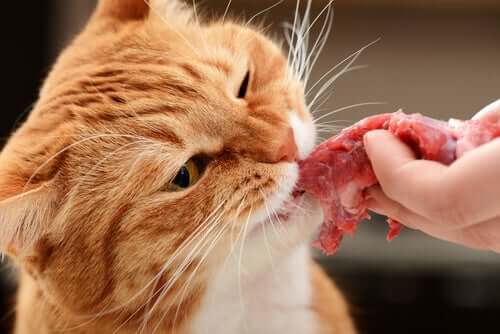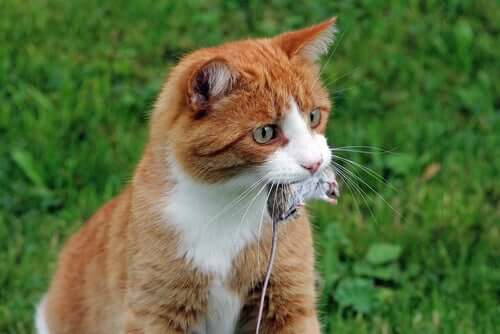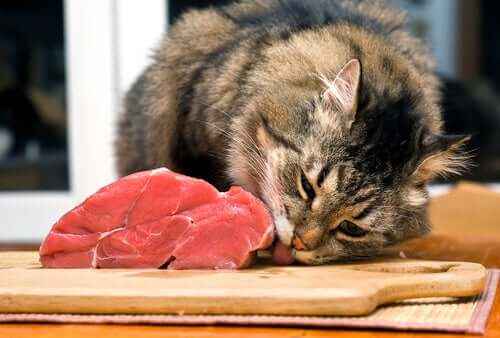All About the Benefits of Raw Food for Cats

At the beginning of the 20th century, the domestic cats’ diet was based on the food that these animals found in rural human settlements. In these areas, it was common for cats to live alongside humans. At the same time, the felines that lived in homes often fed off raw food for cats.
During the Second World War, the use of this type of food fell drastically, both for cats and for dogs. This change was due to the need to redirect resources, including glass, metal, and manpower, to the manufacturing of weapons. Therefore, the production of canned cat food came to a halt and extruded kibble took its place.
The nutrition of wild cats
Cats fall into the category of strict carnivores. This means that their diet consists exclusively of other animals. Therefore, they possess specific characteristics in regards to their claws, teeth, and short digestive tube. These characteristics prepare them fully for the digestion and assimilation of proteins.
What’s more, cats with a diet that’s lacking in protein can end up becoming deficient in certain nutrients. One example of this is taurine–and this deficiency can lead to death.
An example of the diet of a wild feline is that of the European wildcat (Felis silvestris) of the Mediterranean region. This animal feeds on rodents–mainly the wood mouse (Apodemus sylvaticus), the Mediterranean pine vole (Microtus duodecimcostatus), and the southwestern water vole (Arvicola sapidus). At the same time, the common mole (Microtus arvalis) and the red-legged partridge (Alectoris rufa) seem to play an important role in their diet.

Why is raw food good for cats?
Dry and wet cat foods are designed to change the pH of cat urine in order to avoid the formation of kidney stones. However, they aren’t 100% effective.

A natural diet consisting of raw foods–such as the BARF diet–is highly beneficial for the overall health of cats. The benefits of raw food for cats include the following:
- Cats will increase their water intake. A cat’s body consists of at least 60% water. If an animal’s diet is based on raw foods, then he or she will obtain a greater amount of water than with dry cat food.
- Cats that eat raw foods are at lower risk for feline obesity. Raw foods are more nutritional and take longer to digest–although they digest better. As a result, cats take longer to eat.
- A proper diet consisting of raw foods promoting joint health in cats.
- One of the complaints that cat owners often make has to do with the foul odor of cat feces. Raw foods that come from animals hardly contain any carbohydrates. Therefore, they produce much less odor.
- Lastly, if cats eat a diet consisting of raw foods, then this diet will be very similar to that which cats obtain in nature. And, as a result, your feline will be much happier.
So, do you want to introduce your cat to a healthier and more natural diet? The first thing you need to do is talk to a veterinarian that specializes in nutraceuticals and natural feline nutrition. You should never make abrupt changes to your pet’s diet as this lead to serious health problems. What’s more, not all cats accept dietary changes. Therefore, talk to your vet about how to go about this process.
All cited sources were thoroughly reviewed by our team to ensure their quality, reliability, currency, and validity. The bibliography of this article was considered reliable and of academic or scientific accuracy.
- de Animales, A. H. (2010). Guías para la Evaluación Nutricional de perros y gatos de la Asociación Americana Hospitalaria de Animales (AAHA). J Am Anim Hosp Assoc, 46(4).
- Gómez, L. M. (2014). Introducción a la Nutrición de Caninos y Felinos. Journal of Agriculture and Animal Sciences, 2(2).
- Hirakawa, C., & Daristotle, C. (2001). Nutrición Canina y Felina.
- Lozano, J. (2010). Habitat use by European wildcats (Felis silvestris) in central Spain: what is the relative importance of forest variables?. Animal Biodiversity and Conservation, 33(2), 143-150.
- Moleón, M., & Gil‐Sánchez, J. M. (2003). Food habits of the wildcat (Felis silvestris) in a peculiar habitat: the Mediterranean high mountain. Journal of Zoology, 260(1), 17-22.
